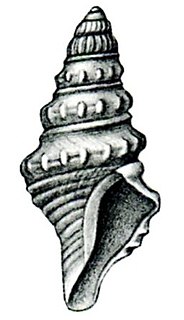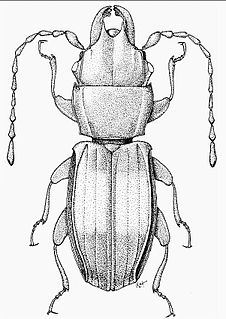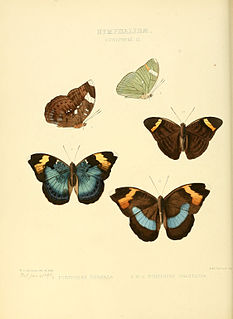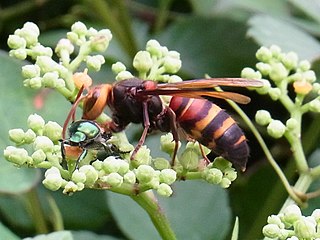Related Research Articles

Eacles is a genus of moths in the family Saturniidae. They are native to the Americas. The genus was erected by Jacob Hübner in 1819.

Stephanie's astrapia, also known as Princess Stephanie's astrapia, is a species of bird-of-paradise of the family Paradisaeidae. This species was first described by Carl Hunstein in 1884.
Megadytes ducalis is a species of water beetle in the family Dytiscidae. With a length of 4.75 cm (1.9 in), it is the largest species in the family. Until recently, the species was only known from a single specimen that was collected in the 1800s from an unknown locality in Brazil, although rumors indicate it was found in the bottom of a canoe in the Amazon. In 2019, a study reported 10 additional specimens, all collected from the end of the 19th century, discovered incidentally in various historical collections. While the original holotype lacked any location data, the new specimens all indicate that they were collected in Santo Antonio da Barra in the southern part of Bahia, Brazil. Villagers in the region were involved in insect trade, capturing the much sought after specimens of Hypocephalus armatus found around the region. As a consequence of the lack of recent records, the IUCN lists it as extinct. Considering the absence of information about the species and the limited studies conducted on water beetles in Brazil, it might still survive.

Megadytes is a genus of diving beetles in the family Dytiscidae. They are found in slow-moving or static freshwater habitats throughout most of the Neotropics, ranging from Florida and Mexico, through the West Indies and Central America, to South America as far south as central Argentina. The adult beetles measure 1.65–4.75 cm (0.6–1.9 in) long depending on the exact species and the largest is also the largest in the family.

Vespa tropica, the greater banded hornet, is a tropical species of hornet found in Southern Asia, New Guinea and west Africa, and which has recently been discovered to be an invasive species on the Pacific island of Guam. It is a predator of paper wasps and possesses a potent sting, which can cause extreme pain and swelling.

Prays is a genus of moths of the family Plutellidae.

Gemmula ducalis is a species of sea snail, a marine gastropod mollusk in the family Turridae, the turrids.

Hemaris ducalis, the Pamir bee hawkmoth, is a moth of the family Sphingidae. It is known from the mountains of south-western Xinjiang in China, the western Tian Shan, southern and eastern Kazakhstan up to the Altai Mountains, western Mongolia, southern Uzbekistan, Kyrgyzstan, Tajikistan, northern Afghanistan and Pakistan.
Vegetia ducalis, the ducal princeling, is a species of moth in the family Saturniidae. It was described by Karl Jordan in 1922. It is found in South Africa.

Sternotomis ducalis is a species of beetle belonging to the family Cerambycidae.

Deinophloeus is a small genus of beetles in the family Laemophloeidae restricted to the New World, where five species are known to occur from Arizona south to Panama. Members of the genus are rather large for the family, ranging from about 2.5 mm to more than 4 mm in length. Members of the genus are characterized by the absence of a frontoclypeal suture, closed procoxal cavities and, in the male, elongate mandibles, clypeal horns, and modified elytral apices. The immature stages are unknown, and nothing is known about their habits or habitats.

Bebearia is a genus of brush-footed butterflies. The species are confined to the Afrotropical realm, mainly in the Guinean Forests of West Africa and the Congolian forests.
Mecyclothorax ducalis is a species of ground beetle in the subfamily Psydrinae. It was described by Sharp in 1903.

Polyneura is a cicada genus from Southeast Asia. Polyneura is a monotypic genus and the type species is Polyneura ducalis.
Ancylonotini is a tribe of longhorn beetles of the subfamily Lamiinae. It was described by Lacordaire in 1869.

Vespa ducalis, the black-tailed hornet, is a hornet and an insect in the genus Vespa. It was described by Smith in 1852. In Japan, it is called himesuzumebachi

Pyrops coelestinus, previously known as Laternaria coelestina, is a species of planthopper belonging to a genus referred-to as lantern-bugs, sometimes known as the blue lantern bug.
Tragocephala ducalis is a species of beetle in the family Cerambycidae. It was described by White in 1856. It is known from South Africa.

Psytalla is a genus of insects belonging to the assassin bugs.
References
- ↑ Biolib.cz - Palimnodes ducalis. Retrieved on 8 September 2014.